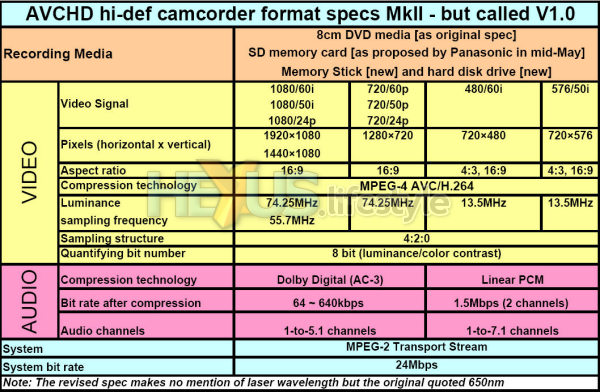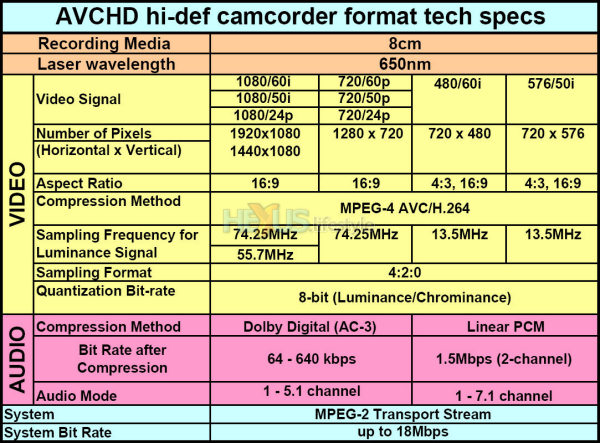AVCHD overview

Late last week, Panasonic and Sony unveiled a raft of changes to AVCHD - the hi-def consumer camcorder format that the two companies first announced back in early May and are aiming at owners of HD TV sets. This week, Sony released some (but not all) details of its first two AVCHD models, due September. One records to DVD, as per the original spec, but the other uses a hard disk - reflecting one of the three main changes seen in the revised specs for this MPEG-4-based camcorder standard.
Panasonic has yet to give news of its own AVCHD camcorder launches but a phone call today to the company's UK offices did reveal that an announcement is pending.
As you can see from the two tables below, the original proposed recording media - 8cm DVDs - has been joined not just by hard disks but also by two types of memory card - and what they are isn't hard to guess. Sony's own Memory Stick format is included, of course, and so is - as per Panasonic's proposal in mid-May - SD (Secure Digital), the format developed by Panasonic in collaboration with SanDisk and Toshiba.
The three new recording-media options make massive sense given that the storage capacity of 8cm blanks is very limited - just 1.46GB per side nominal but only 1.36GB once formatted. Perhaps the only real surprise about the addition of hard disks and memory cards to the specs is that Panasonic and Sony didn't include them at the outset.
Back in May, Sony reckoned that a single-layer 8cm disc could hold 20 minutes of AVCHD high-def but didn't say whether this was 720p (as we assumed at the time) or finer-grained 1080i. We pointed out back then, though, that whatever the case, since 720/50p has over four times the resolution of SD PAL and yet a standard-definition camcorder can only record 10 minutes more. This remarkable achievement is made possible by AVCHD's use of high-efficiency MPEG-4/H.264 encoding
This time round, Sony has been a little bit more forthcoming - though not about single-layer discs. It claims that a DL disc allows its first DVD AVCHD model, the HDR-UX1E (likely all-up street price, £1,000), to record around 60 minutes' of HD video in 5Mbps long-play mode, 45 minutes' in the default 7Mbps standard-play mode and 27 minutes' of "top-quality" footage in a "new" 12Mbps AVCHD 12M (HQ+) mode.
What Sony doesn't say, however (just as before), is what the video resolution is used in any of these modes, though it does add that the camcorder can write to DVD-R, DVD-RW and DVD+RW - but without mentioning DVD+R, which we'd kind of presume it's likely to handle, too (but who knows?).
Verbatim announced a while ago that it would be offering DL 8cm discs with an unformatted capacity of 2.6GB and though they are available now, the price per disc is pretty choice - not far short of a fiver, which be tough to swallow if you regularly buy 12cm blanks for well less than 50p a pop.
But even DL 8cm discs look limp when compared with new-generation 4MB SD cards and Memory Sticks. These bigger-capacity card are far from cheap, however, but are going to fall in price.
And, of course, 1GB SD cards are already down at pocket-money prices. But it's in comparison with the capacity of hard disks that 8cm DVDs really fall down. They look positively puny when put up against even the sort of small-size hard drives that are currently available for use in camcorders.
Sony's first hard-disk-based AVCHD camcorder, the HDR-SR1E (£1,100), will carry a 30GB (unformatted) hard drive as will a new pair of standard-definition camcorders - the DCR-SR30E and DCR-SR50E. However, there's scope for drives of greater capacity, as demonstrated by another standard-def camcorder that Sony also unveiled, the 60GB DCR-SR70E. We'll be be reporting on these three SD models later.
The HDR-SR1E AVCHD camcorder with its 30GB drive offers a different package of recording modes than the DVD-based AVCHD model. These are said to include the same 5Mbps long-play mode (promising 11 hours' recording) and default 7Mbps setting (8 hours 30min) but also take in a 9Mbps mode (7 hours) and a "special new super-quality" 15Mbps XP mode (4 hours) claimed to achieve "outstanding results in terms of detail, clarity and colour".
Again, though, Sony gives no detail of the resolution at which video is recorded in any modes but what is clear is that the inclusion of a hard disk will enable users to shoot a lot more footage at higher resolutions than using DVD or memory card - and that can only be to the good.
While incorporating a hard disk does massively increases the recording capacity and make high-resolution shooting more convenient, its other effects on the camcorders are far from clear. We don't know, for example what the weight is of either AVCHD camcorders nor their battery lives.
So, who's to say whether the hard-disk model isn't twice the weight of its companion (or, indeed, vice versa)? What's also left unanswered is whether the life of the rechargeable battery supplied with the HDD variant is anything like long enough to match the potential recording time or even whether you'd get close by using any far more powerful (and possibly expensive) optional battery that Sony might decide to offer?
One other thing to note - Panasonic and Sony have also made known the companies that are supporting AVCHD. In terms of CE-hardware makers, the names are Canon, Pioneer, Samsung and Sharp.
On the software side, there's Adobe (with its Production Studio bundle), plus CyberLink (PowerDVD player and PowerDirector for authoring); InterVideo (WinDVD player) and its daughter company Ulead (Video Studio editing/authoring, DVD MovieWriter); Nero (Nero 7 Premium/Ultra Edition for authoring); Roxio/Sonic (Easy Media Creator 9); and Sony's own media software arm with Vegas 7.0, for editing.
But what do Sony's two AVCHD camcorders themselves have to offer? Well, dive over to the next page and we'll tell you all that we know...











